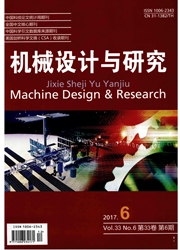

 中文摘要:
中文摘要:
针对淬硬轴承钢的干态车削过程,在Abaqus中建立考虑PCBN刀尖半径的热力耦合三维有限元切削模型。首次仿真预测出周期性绝热剪切引起的三维锯齿形切屑,并且切屑在刀屑接触面上的特征线和材料挤压流动方向,以及切屑自由表面沿进给量方向和沿切削深度方向的切屑形态与实际加工形成的切屑形态都能够很好的吻合。通过对切削力、切削温度,切削力和切屑形态预测分析,并与实验数据的比较,揭示了刀尖半径和主偏角对切削过程的影响。研究发现:刀尖半径增大到0.8mm时,工件材料挤压变形更显著,平均切向力增大了17N,与实验结果比较相符.、斜角切削过程中材料受到的挤压变形力更大,温升更加明显,最高温度达到l289℃,与试验测量的切削区平均温度11()()℃接近;预测的平均切向力为150N,与实验值相差只有7%..
 英文摘要:
英文摘要:
A thermo-mechanical three-dimensional finite element model (FEM) is developed based on Abaqus software to simulate the high-speed hard turning process,by PCBN cutting tool with a large tool nose radius. This paper simulates 3D sawtooth chip induced by periodic adiabatic shear, and validates that the chip characteristic line and material flow direction on the chip-tool interface, the chip morphology on the free surface along feed direction and the cutting depth direction, are all well matched with the actual measured chip morphology. The predicted chip morphology, cutting forces, cutting temperature and plastic strain distribution are compared with experimental data to analyze the effect of tool nose radius and lead angle on hard machining hardened bearing steel. It iudictes that, the temperature/strain on the chip is relatively higher, and average tangential force increased about 17 N using cutting tool with lager nose radius 0.8mm, this is consistent with the experimental results. During oblique cutting process, cutting tool with lead angle enables workpieee material deform more severely and cutting temperature relatively larger, the maximum temperature on the chip-tool interface reaches 1 289℃ , which is close to the measured average temperature in the cutting area around 1 100℃; Predicted average tangential force is 150 N, and 7% difference with the experimental data.
 同期刊论文项目
同期刊论文项目
 同项目期刊论文
同项目期刊论文
 Experimental study on surface residual stress scatter of bearing steel produced by sequential grindi
Experimental study on surface residual stress scatter of bearing steel produced by sequential grindi 期刊信息
期刊信息
